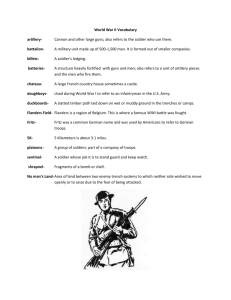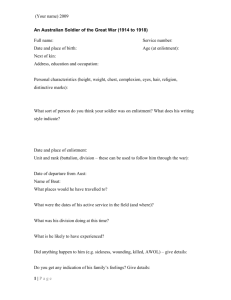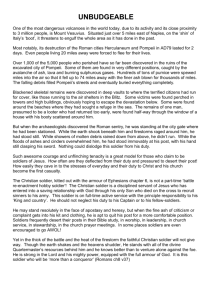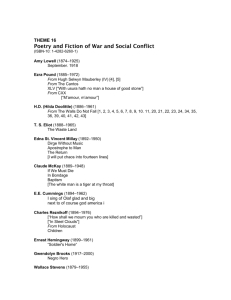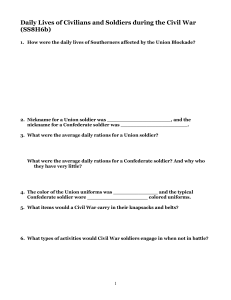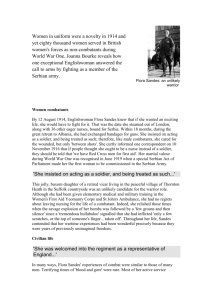Unit 5: Sensation and Perception Practice AP Write/Response Paper
advertisement
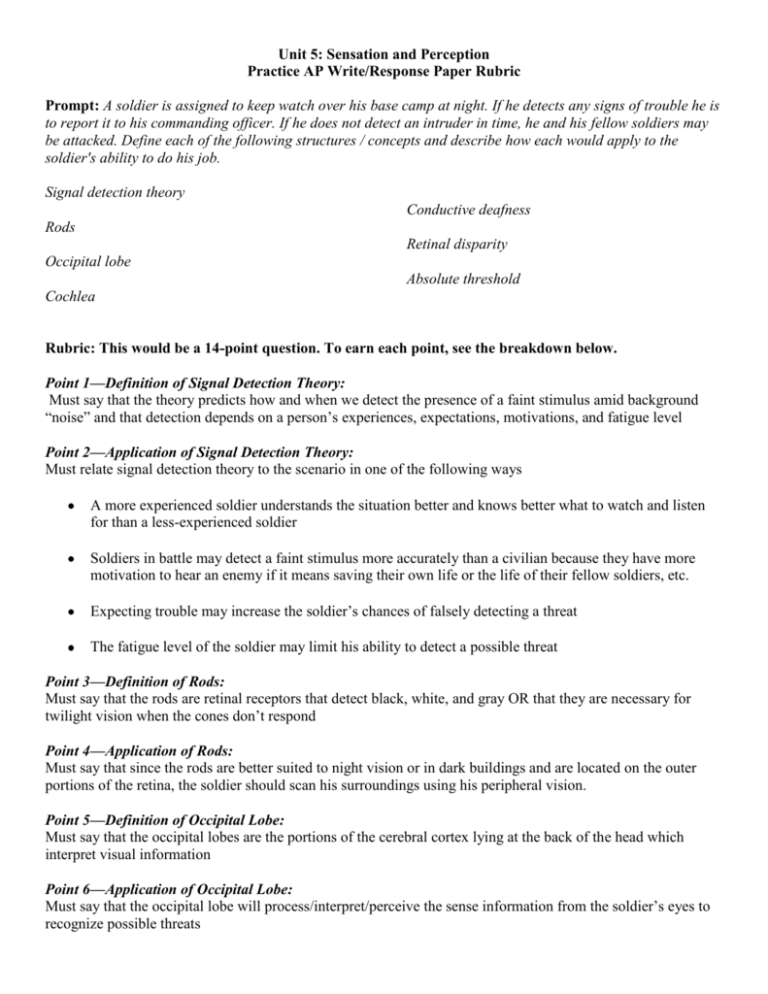
Unit 5: Sensation and Perception Practice AP Write/Response Paper Rubric Prompt: A soldier is assigned to keep watch over his base camp at night. If he detects any signs of trouble he is to report it to his commanding officer. If he does not detect an intruder in time, he and his fellow soldiers may be attacked. Define each of the following structures / concepts and describe how each would apply to the soldier's ability to do his job. Signal detection theory Conductive deafness Rods Retinal disparity Occipital lobe Absolute threshold Cochlea Rubric: This would be a 14-point question. To earn each point, see the breakdown below. Point 1—Definition of Signal Detection Theory: Must say that the theory predicts how and when we detect the presence of a faint stimulus amid background “noise” and that detection depends on a person’s experiences, expectations, motivations, and fatigue level Point 2—Application of Signal Detection Theory: Must relate signal detection theory to the scenario in one of the following ways A more experienced soldier understands the situation better and knows better what to watch and listen for than a less-experienced soldier Soldiers in battle may detect a faint stimulus more accurately than a civilian because they have more motivation to hear an enemy if it means saving their own life or the life of their fellow soldiers, etc. Expecting trouble may increase the soldier’s chances of falsely detecting a threat The fatigue level of the soldier may limit his ability to detect a possible threat Point 3—Definition of Rods: Must say that the rods are retinal receptors that detect black, white, and gray OR that they are necessary for twilight vision when the cones don’t respond Point 4—Application of Rods: Must say that since the rods are better suited to night vision or in dark buildings and are located on the outer portions of the retina, the soldier should scan his surroundings using his peripheral vision. Point 5—Definition of Occipital Lobe: Must say that the occipital lobes are the portions of the cerebral cortex lying at the back of the head which interpret visual information Point 6—Application of Occipital Lobe: Must say that the occipital lobe will process/interpret/perceive the sense information from the soldier’s eyes to recognize possible threats Point 7—Definition of Cochlea: Must say that the cochlea is the coiled bony, fluid-filled section of the inner ear Point 8—Application of Cochlea: Must say that the cochlea is where transduction occurs OR where sound waves are converted to a neural impulse Cannot simply say that the cochlea is for hearing. Point 9—Definition of Conductive Deafness (Conduction Hearing Loss): Must say that conductive deafness is caused by damage to the mechanical system (i.e. ossicles) that conducts sound waves to the cochlea Cannot say that this is caused by damage to the cochlea, inner ear, or auditory nerve Point 10—Application of Conductive Deafness: Must say that because of conduction deafness (conduction hearing loss) the soldier will not be able to sense the sound waves that may otherwise alert him of a possible threat Point 11—Definition of Retinal Disparity: Must say that retinal disparity is a binocular cue for depth perception in which the brain computes distance based on the difference between the two images sent from the eyes (if they mention difference between both eyes, does not have to use the word binocular) Point 12—Application of Retinal Disparity: Must say that the soldier must use retinal disparity to judge the distance of a possible threat, target, while driving, while running, etc. Point 13—Definition of Absolute Threshold: Must say that absolute threshold is the minimum stimulation needed to detect a particular stimulus fifty percent of the time. Point 14—Application of Absolute Threshold: Must say that if the stimuli emitted by the possible threat does not exceed the absolute threshold, then the soldier will not be able to sense the threat and warn his comrades.
